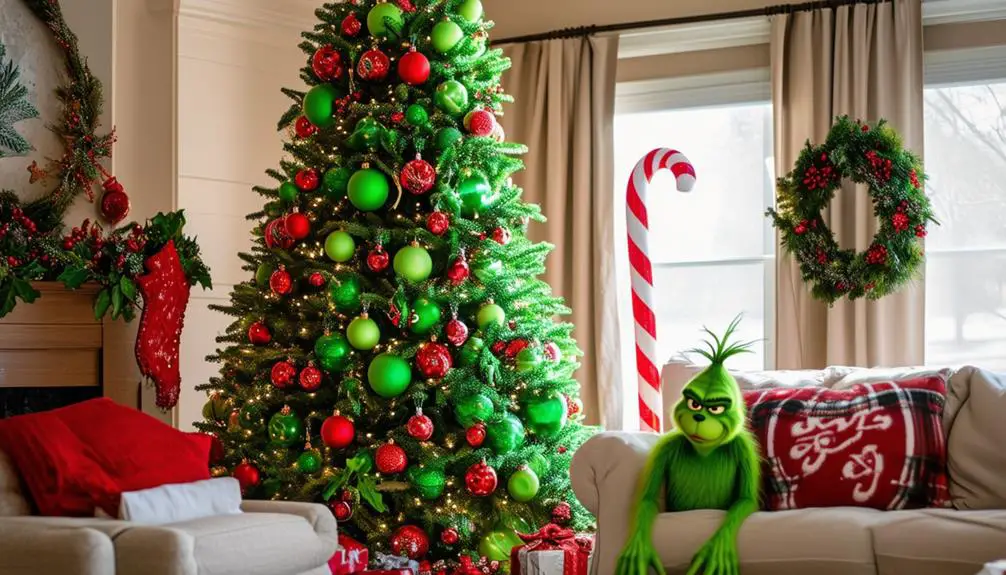As you start brainstorming ideas for your succulent garden, you're likely wondering where to begin. With so many design possibilities, it's easy to get overwhelmed. But by considering a few key elements, like balance, harmony, and texture, you can create a visually stunning and thriving outdoor space that showcases these low-maintenance plants. From desert landscapes to small space gardens, the versatility of succulents offers endless opportunities for creativity. But what if you could take your design to the next level by incorporating unique planters, decorative elements, and clever color schemes?
Succulent Container Garden Ideas

Six succulent container garden ideas await you, each carefully crafted to showcase the unique beauty of these low-maintenance plants.
You'll discover how to create visually stunning arrangements that highlight the succulents' striking shapes, vibrant colors, and intriguing textures. From modern to rustic, these container themes cater to diverse tastes and styles.
To add a pop of color, incorporate succulent accents like Echeveria or Crassula, which come in an array of hues.
Alternatively, play with contrasting textures by combining smooth-leaved Aeonium with spiky Agave. For a whimsical touch, incorporate decorative containers with unique shapes or patterns. Consider a sleek, modern planter to showcase the architectural beauty of succulents like Kalanchoe or Sedum.
As you explore these container garden ideas, remember to balance your design with a mix of heights, colors, and textures.
This harmonious blend will create an enthralling visual display that showcases the succulents' natural beauty. With these inspiring ideas, you're ready to tap into your creativity and craft a show-stopping succulent container garden that will impress friends and family alike.
Desert Landscape Design Inspiration
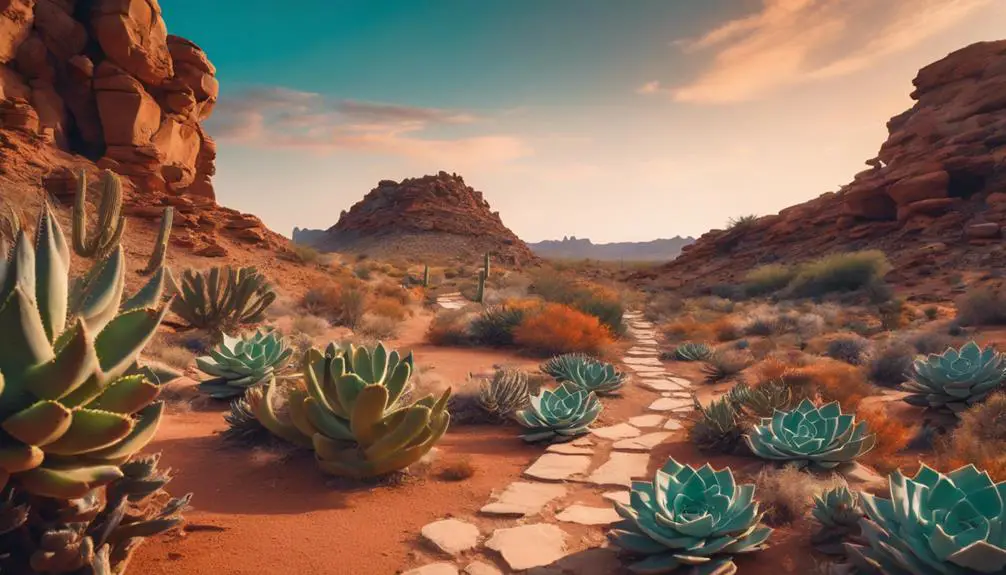
As you envision your desert landscape design, consider the dramatic impact of cacti and rock formations, which can create a striking visual contrast against the arid backdrop.
You'll want to select plants that thrive in hot, dry conditions, such as succulents, yucca, and ornamental grasses.
Cacti and Rock Formations
Incorporate cacti and rock formations into your succulent garden design to evoke the dramatic, arid landscape of the desert, where these resilient plants thrive amidst weathered stone outcroppings and sandy dunes.
You can create a visually striking arrangement by grouping cacti of varying shapes and sizes, such as towering columnar cacti, globular species, and trailing varieties.
Consider a focal point, like a statement piece of driftwood or a striking rock formation, to anchor your design.
When selecting rock formations, choose stones with unique textures and colors to add depth and visual interest.
You can arrange rocks in a natural, organic pattern or create a more structured design, like a spiral or grid.
Cacti arrangements can be scattered throughout the rock formations, or you can create a more formal, symmetrical design.
Don't be afraid to experiment and move plants and rocks around until you achieve a look that feels balanced and visually appealing.
Arid Climate Plant Choices
You'll want to select arid climate plants that not only thrive in hot, dry conditions but also provide striking visual interest, like the vibrant flowers of Desert Marigold or the silvery foliage of Texas Sage.
When designing your succulent garden, prioritize plants with high heat tolerance, as they'll perform best in dry climates. Look for species with adapted features, such as waxy stems, fuzzy leaves, or deep roots, which enable them to conserve water and withstand scorching temperatures.
Some top picks for arid climate plants include the majestic Ocotillo, with its whip-like branches and clusters of red flowers, and the low-maintenance Creosote Bush, which can survive for years without water.
The delicate, lacy foliage of Desert Fern adds a touch of elegance, while the towering, columnar shape of Cardón Cactus provides dramatic structure.
Small Space Succulent Gardens
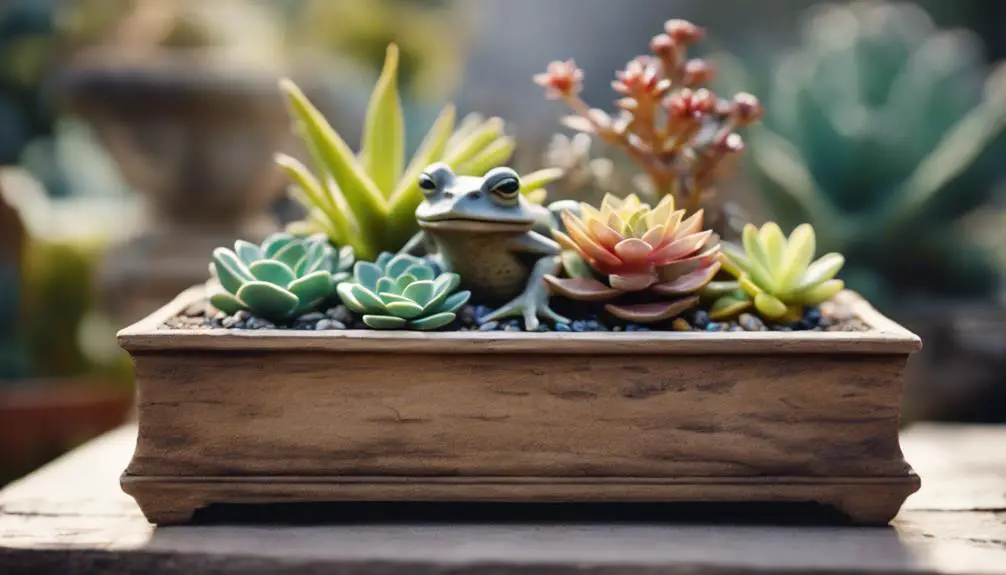
With limited square footage, small space succulent gardens require careful planning to maximize visual impact and accommodate a variety of species. You'll need to think vertically and select plants that thrive in compact conditions.
Consider tiny terraces, where shallow containers can be placed on a small patio or balcony. These micro-gardens can be designed to fit snugly into cozy corners, providing a burst of greenery in an otherwise urban landscape.
When choosing succulents for your small space garden, look for compact or dwarf varieties that won't outgrow their containers. Echeveria, Crassula, and Sedum are excellent options, as they come in a range of shapes, sizes, and colors.
To add visual interest, incorporate a mix of textures, such as smooth-leaved Aloe and fuzzy-leaved Kalanchoe.
Don't forget to leave space between plants for air circulation and growth. A well-planned small space succulent garden can be just as stunning as a larger one, and it's a great way to bring some greenery into your life, even in the smallest of spaces.
Vertical Succulent Garden Designs
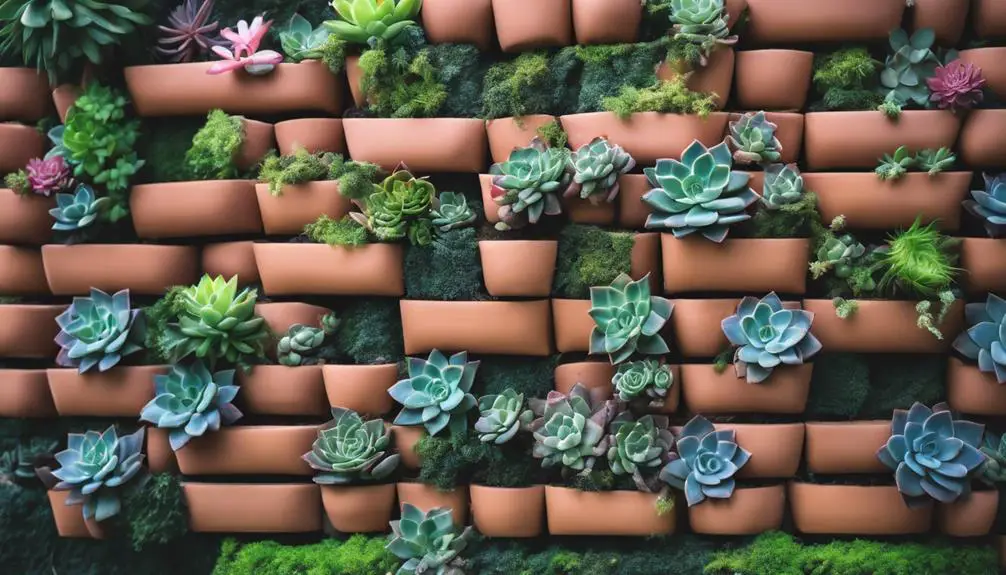
As you explore vertical succulent garden designs, you'll discover a range of creative options that maximize space and add visual interest.
You can opt for wall-mounted planters that create a striking display, or choose succulent frame designs that add a touch of modern elegance.
Alternatively, you can create living wall art that brings a touch of nature indoors, all while showcasing your favorite succulent species.
Wall-Mounted Planters
Incorporating wall-mounted planters into your succulent garden design allows for a visually striking and space-saving way to showcase your plants, perfect for small gardens, indoor spaces, or urban landscapes.
By using wall-mounted planters, you can create a unique and modern wall decor that adds a touch of elegance to your space.
Hanging arrangements can be designed to cascade down walls, creating a beautiful display of succulents that will catch everyone's attention.
When selecting wall-mounted planters, consider the type of succulents you'll be using and their growth habits.
Choose planters with good drainage and aeration to guarantee your succulents thrive.
You can also mix and match different planter sizes and shapes to add visual interest to your design.
To take it to the next level, incorporate LED grow lights or a trellis system to create a truly show-stopping display.
With wall-mounted planters, the possibilities are endless, and you'll be able to create a stunning succulent garden that's both functional and beautiful.
Succulent Frame Designs
You can take your wall-mounted succulent display to new heights by designing a succulent frame that creates a stunning vertical succulent garden, where lush greenery appears to burst forth from the frame's edges.
To achieve this, consider the frame's material, shape, and size. A wooden or metal frame with a geometric shape, such as a hexagon or triangle, can add visual interest to your design.
You can also incorporate frame accents, like a decorative trim or a natural wood finish, to enhance the overall aesthetic.
When arranging your succulents, experiment with different succulent patterns to create a visually appealing display.
You can create a symmetrical pattern by placing identical succulents on either side of the frame's center, or a more organic look by grouping succulents of varying sizes and shapes together.
Consider the succulents' colors, textures, and growth habits when selecting your plants.
Living Wall Art
By attaching a trellis or a grid system to a wall, you can create a living wall art piece that transforms a vertical space into a lush, thriving succulent garden. This innovative wall decor idea allows you to maximize space, adding a touch of greenery to even the smallest of areas.
When designing your living wall art, consider the type of succulents you want to use, as some species thrive in vertical conditions more than others. A well-draining potting mix and a precise irrigation system are also vital to guarantee the health and longevity of your plants.
To create an urban oasis, choose a mix of succulent species with varying textures, colors, and shapes. This will add depth and visual interest to your living wall art.
You can also incorporate other decorative elements, such as mosses, ferns, or air plants, to create a unique and eye-catching design.
With proper care and maintenance, your living wall art will become a stunning focal point in any room, bringing a touch of natural beauty to your indoor space.
Succulent Color Scheme Options

What hues will dominate your succulent landscape: soft pastels, bold brights, or a mix of earthy tones?
When it comes to choosing a color scheme for your succulent garden, you have a wide range of options.
If you're aiming for a cohesive look, ponder a Monochromatic Neutrals approach, where you select a single neutral hue and vary its intensity to create visual interest. Shades of green, beige, and gray work well for this style.
For a bolder statement, incorporate Vibrant Accents to add pops of color. Bright corals, blues, and yellows can add a fun and playful touch to your design.
Alternatively, you can choose a mix of earthy tones, such as terracotta, sienna, and umber, to create a natural and organic look.
Remember to weigh the natural colors of your succulents and the surrounding environment when selecting your color scheme. By doing so, you'll create a visually stunning and harmonious succulent landscape that showcases your unique style.
Mixing Succulents With Flowers
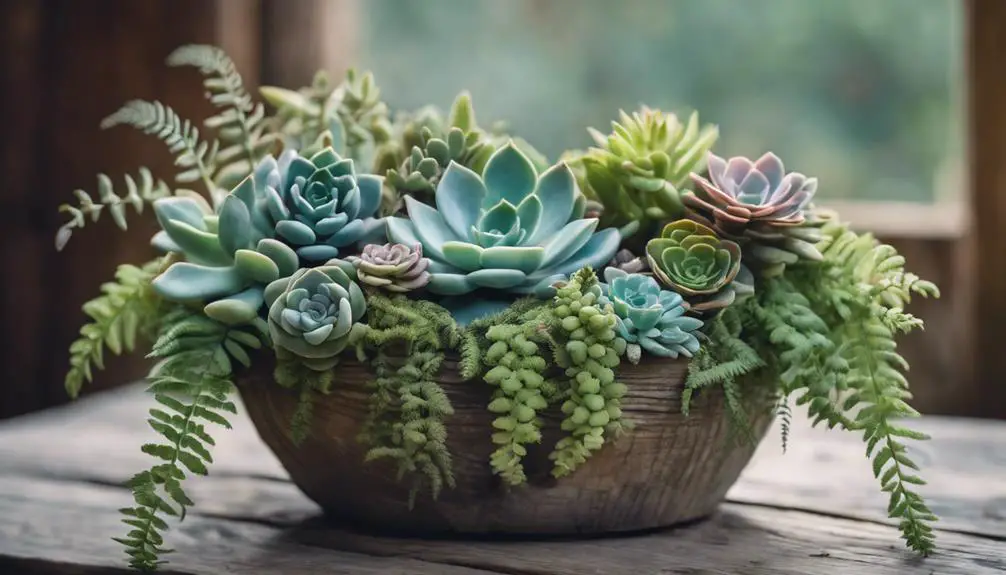
As you combine succulents with flowers in your garden design, you'll want to ponder three key points to create a visually stunning display.
You'll add pops of color with floral accents, soften the geometric shapes of succulents with delicate blooms, and create whimsical contrast with varying textures.
Colorful Floral Accents
You can inject vibrant personality into your succulent garden design by incorporating colorful floral accents that harmonize with the shapes and textures of your succulents.
By doing so, you'll create a visually stunning contrast between the soft, delicate petals of flowers and the rugged, architectural forms of succulents.
Vibrant petals in shades of pink, yellow, and orange can add a pop of color to your design, while bold blooms like sunflowers or gerbera daisies can create a dramatic focal point.
To guarantee a cohesive look, choose flowers with similar growing conditions to your succulents, such as drought-tolerant varieties like zinnias or marigolds.
Consider mixing flowers with similar bloom times to create a dynamic, ever-changing display.
For example, pair spring-blooming bulbs like tulips or daffodils with succulents that thrive in cooler weather, like echeveria or crassula.
Softening Succulent Shapes
By combining succulents with flowers, you can soften their architectural shapes, creating a harmonious balance of forms and textures that adds depth and visual interest to your garden design.
This fusion of shapes and textures creates a soft focus effect, where the bold, geometric forms of succulents are tempered by the delicate, organic curves of flowers.
The result is a visually appealing contrast that engages the viewer and invites exploration.
To achieve this effect, choose flowers with gentle curves, such as roses or peonies, and pair them with succulents that have strong, architectural shapes, like echeverias or crassulas.
Consider the scale and proportion of the plants, ensuring that the flowers don't overwhelm the succulents, and vice versa.
By balancing the shapes and textures, you'll create a dynamic, yet harmonious composition that adds visual interest to your garden.
This approach allows you to showcase the unique qualities of both succulents and flowers, resulting in a riveting and innovative garden design.
Whimsical Textural Contrast
Mixing succulents with flowers that boast delicate, lacy, or ruffled textures creates a whimsical textural contrast that adds an extra layer of visual intrigue to your garden design.
You'll be amazed at how this combination elevates your succulent arrangement from ordinary to extraordinary.
To achieve this look, pair succulents with flowers that exhibit Fanciful Foliage, such as ferns, sweetpeas, or cosmos.
The lacy, delicate patterns of these flowers will beautifully contrast with the smooth, plump leaves of your succulents.
As you design your Whimsy Wonders, consider the scale and proportion of your plants.
Balance tall, statuesque succulents with shorter, more delicate flowers.
This contrast in height will add depth and visual interest to your arrangement.
Don't be afraid to experiment with different textures and colors to create a unique, one-of-a-kind design.
By combining succulents with flowers that boast delicate textures, you'll create an enchanting display that will draw the eye and inspire the imagination.
Succulent Rock Garden Designs

Incorating succulents into a rock garden design creates a visually striking contrast between the soft, fleshy plants and the rugged, textured stones.
As you plan your succulent rock garden, consider incorporating rock accents to add depth and visual interest. Strategically place large rocks or boulders to create a sense of balance and harmony. You can also use smaller rocks to create a beautiful, intricate pattern around your succulents.
To take your design to the next level, consider adding pebble paths that wind through your garden. These paths won't only add visual appeal but also make it easy to navigate through your garden.
You can use different colors and textures of pebbles to create a unique and eye-catching design. As you choose your succulents, select a variety of shapes, sizes, and colors to add visual interest.
Consider grouping similar succulents together or creating a gradient of colors to create a stunning display. With careful planning and attention to detail, you can create a succulent rock garden that's both beautiful and unique.
DIY Succulent Garden Projects
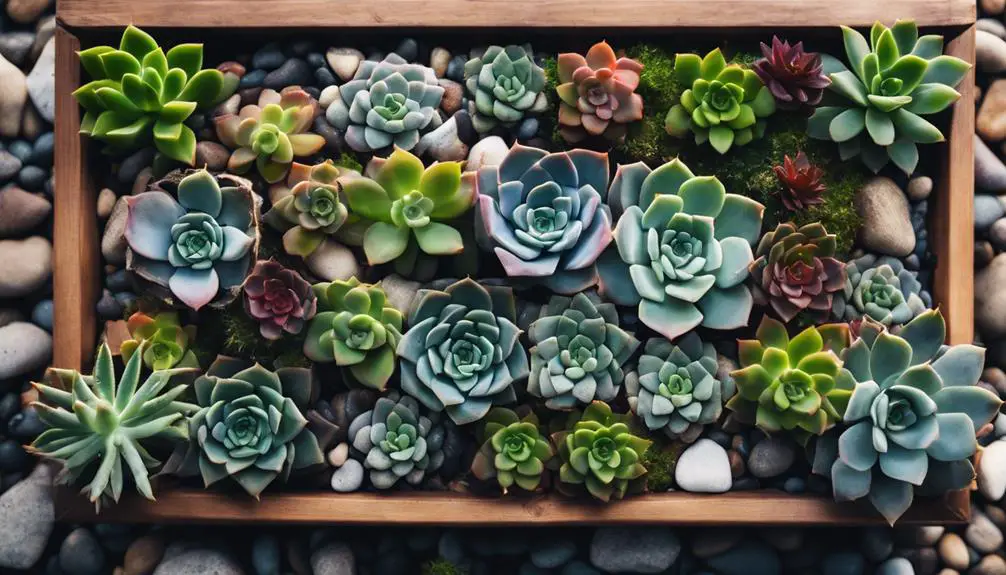
Create a stunning succulent centerpiece with a DIY terrarium project, where you can combine your favorite succulent varieties with decorative rocks, moss, and driftwood in a glass container. This succulent craft is a great way to add a touch of elegance to your home decor.
Follow a DIY tutorial to learn how to create a visually appealing arrangement that showcases the unique textures and colors of your succulents.
For a more rustic look, try creating a succulent wreath using a wire or foam base, some wire cutters, and your favorite succulent species.
Simply attach the succulents to the base using floral wire or hot glue, and add some decorative elements like pinecones or ribbons.
You can also upcycle an old planter or pot by adding a succulent arrangement with a mix of textures and colors.
With these DIY succulent garden projects, you can tap into your creativity and create unique and innovative designs that showcase your love for succulents.
Whether you're a seasoned crafter or a beginner, these projects are easy to follow and require minimal materials.
Indoor Succulent Garden Ideas
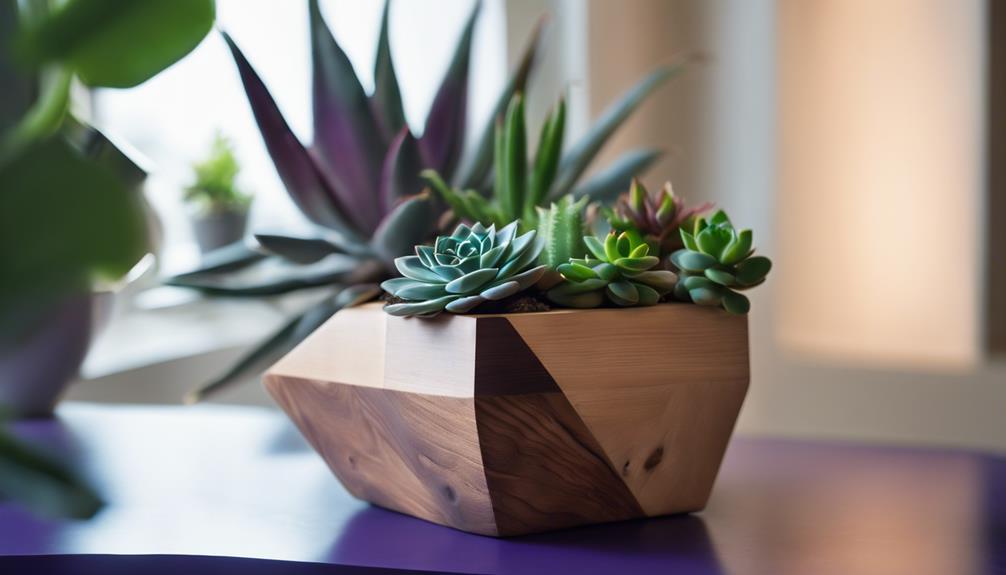
Transform your indoor space with a lush succulent garden, carefully selecting species that thrive in low-light conditions and incorporating unique planters, such as vintage tea cups or wooden crates, to add visual interest.
When it comes to succulent care, remember that most species require infrequent watering and indirect sunlight, making them perfect for indoor spaces.
To create a stunning indoor succulent garden, start by choosing a planter that complements your existing decor. Consider using a geometric terrarium or a hanging basket to add depth and dimension to your space.
Next, select a variety of succulents with different textures, shapes, and sizes to create visual interest. Arrange them in a way that creates a sense of balance and harmony, leaving enough space between each plant for proper air circulation.
To take your indoor succulent garden to the next level, incorporate decorative elements such as pebbles, moss, or driftwood to add a touch of whimsy.
With proper care and attention, your indoor succulent garden will thrive, becoming a beautiful and low-maintenance addition to your indoor decor.
Succulent Border Garden Designs
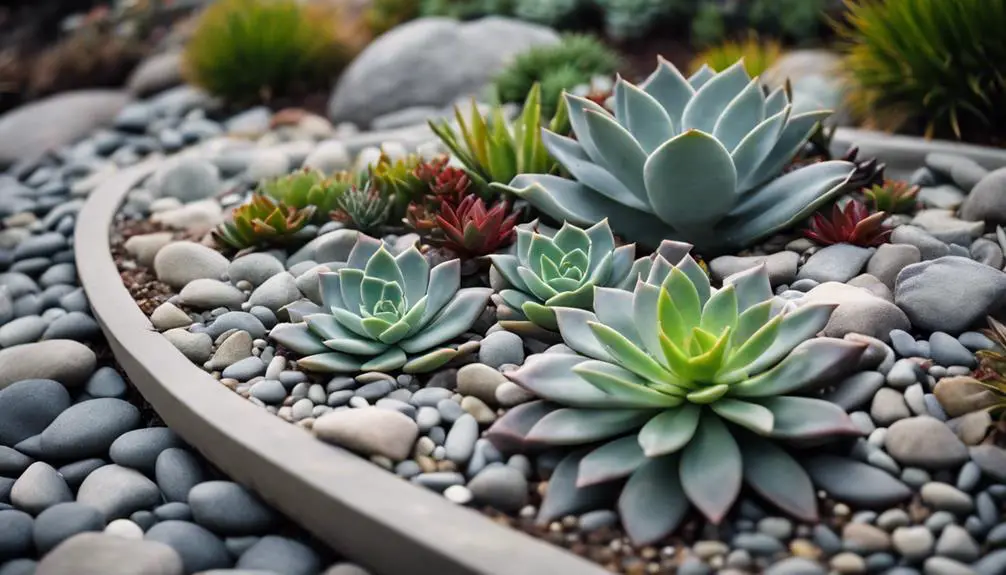
As you design your outdoor space, consider defining your borders with a succulent garden, where carefully chosen species can thrive in narrow spaces and add a burst of color and texture to your landscape.
A well-designed succulent border garden can elevate your entire outdoor aesthetic, creating a visually striking shift between your lawn and hardscapes.
To achieve this, focus on creating succulent edges that are both beautiful and functional.
Start by selecting succulent species with varying textures, forms, and colors to create a dynamic border.
Consider combining tall, upright succulents like aloe or agave with low-growing, spreading varieties like sedum or echeveria.
This contrast will add depth and visual interest to your border.
Don't forget to incorporate border textures, such as the soft, fuzzy leaves of kalanchoe or the sharp, architectural lines of cacti.
Unconventional Succulent Planters
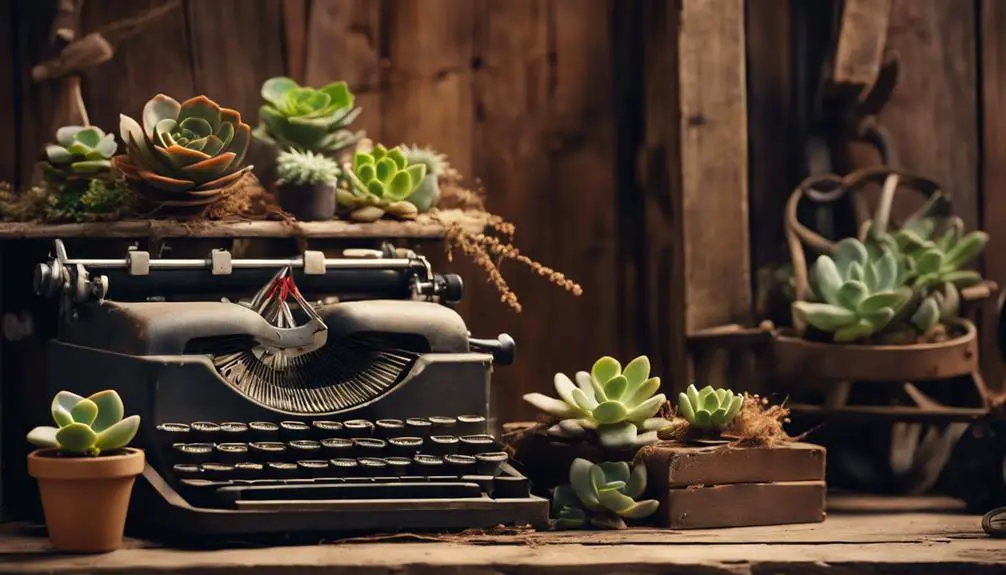
You can repurpose unexpected containers, like vintage boots, tea cups, or even broken machinery, into unique succulent planters that add an edgy, whimsical touch to your garden or indoor space.
By thinking outside the box (or planter), you can create a one-of-a-kind display that showcases your succulents in a fresh and exciting way.
Vintage boots, for instance, can be transformed into charming planters that add a rustic, country charm to your space. Simply drill a few holes in the bottom for drainage, add some soil and your chosen succulents, and you're good to go!
Rustic crates, on the other hand, can be used to create a stunning vertical garden that's perfect for small spaces. By attaching the crates to a wooden board or trellis, you can create a visually striking display that's both functional and decorative.
Whatever unconventional container you choose, make sure it's clean, dry, and has proper drainage to guarantee your succulents thrive. With a little creativity, you can turn any old item into a beautiful, thriving succulent planter.
Succulent Theme Garden Ideas

By incorporating a unifying theme, you can elevate your succulent garden from a mere collection of plants to a cohesive, visually stunning display that showcases your personal style and creativity.
A well-executed theme can transform your outdoor space into an immersive experience that tells a story or evokes a specific mood. For instance, you can create a whimsical fairy garden by combining tiny succulents with miniature furniture and accessories, transporting visitors to a fantastical world.
Alternatively, you can design a romantic succulent wedding garden, perfect for intimate ceremonies or photo shoots, featuring soft pastel hues and delicate, lace-like foliage.
To execute your theme effectively, select succulent species that fit your narrative, and balance them with complementary hardscape elements, such as stones, wood, or metal accents.
Don't be afraid to add decorative props or accessories that reinforce your theme, like tiny figurines or wedding bells.
Succulent Lighting Design Tips
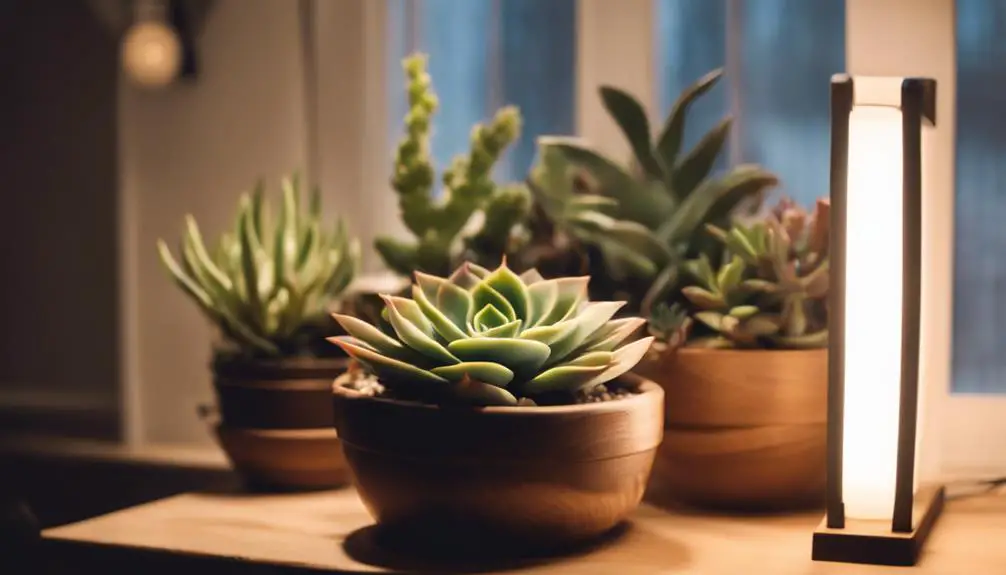
Proper lighting can make or break the visual impact of your succulent garden, and strategically positioning lights can accentuate the unique textures and colors of your plants.
To create a stunning display, consider using daylight simulation lighting, which mimics natural outdoor light. This type of lighting is especially effective for showcasing succulents with intricate patterns or vibrant hues.
For a more dramatic effect, you can also use artificial shading to create contrast and add depth to your arrangement. By placing lights at specific angles, you can create areas of highlight and shadow, drawing attention to specific plants or features.
When selecting lights, choose LED grow lights or low-wattage spotlights, which provide focused illumination without generating excessive heat.
Avoid harsh overhead lighting, which can wash out the colors and textures of your succulents. Instead, opt for more subtle, directional lighting that creates visual interest and invites exploration.
Frequently Asked Questions
How Often Should I Water My Succulents in the Winter?
During winter, you'll want to reduce watering to once every 4-6 weeks, as succulents enter dormancy period; monitor soil moisture, and adjust your winter watering schedule accordingly to prevent root rot and guarantee healthy growth.
Can I Grow Succulents in a Shaded Area?
You can grow succulents in shaded areas, but choose shaded species that thrive in low-light conditions. If needed, supplement with artificial lighting to guarantee ideal growth, as most succulents require bright, indirect light.
Are All Succulents Safe for Pets and Children?
When selecting succulents, you'll find not all are safe for pets and children, as some toxic varieties can cause harm. Instead, opt for pet-friendly alternatives like aloe, echeveria, and crassula, ensuring a safe and thriving environment for all.
Can I Propagate Succulents From Leaves or Only Stems?
You can propagate succulents from leaves, not just stems, with most succulent varieties. Select healthy, plump leaves with a slight twist at the base, and let them dry for a few days to form a callus before planting.
Do Succulents Need Fertilization to Thrive?
You'll boost your succulent's growth by providing targeted fertilization, as they require precise nutrition. Timing is key: fertilize during active growing seasons, avoiding dormant periods, to promote healthy development and vibrant colors.
Conclusion
As you bring your succulent garden design to life, remember to balance contrasting textures, harmonize with complementary colors, and add whimsy with unexpected elements.
Don't be afraid to experiment with unique planters, vibrant flowers, and creative lighting.
By incorporating these design principles, you'll craft a visually stunning outdoor space that's both low-maintenance and breathtakingly beautiful.


